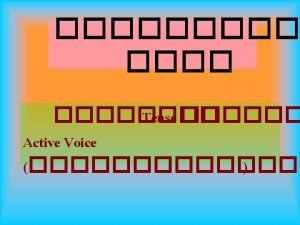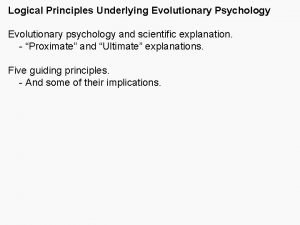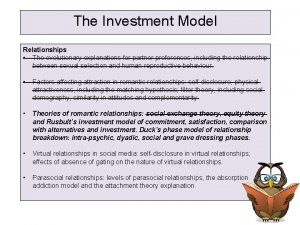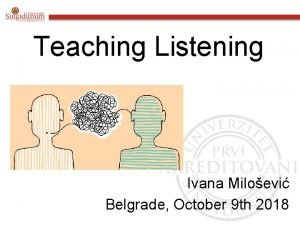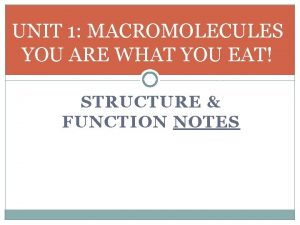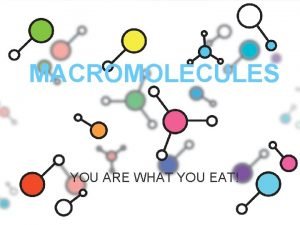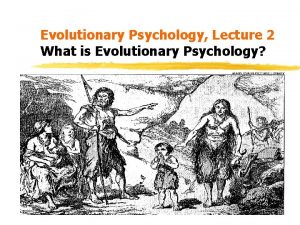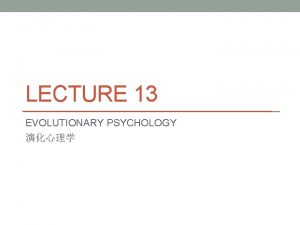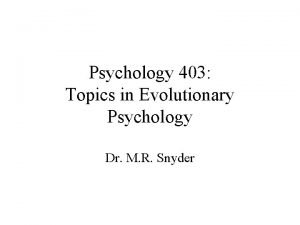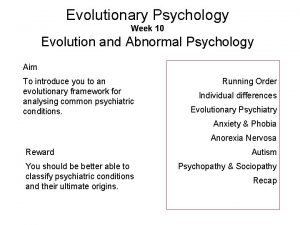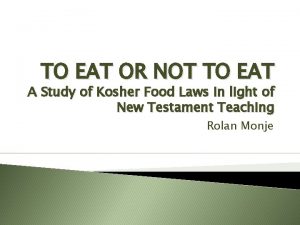You Are What You Eat Evolutionary Psychology Spring




















- Slides: 20

You Are What You Eat Evolutionary Psychology Spring 2021 Dr Chapman 1

Combating the Hostile Forces of Nature Survival Problems: see The Great Struggles of Life from Introduction topic slides #8 and #9 o o o Climate and Weather Food Shortages Toxin Disease Parasites Predators Hostile Conspecifics These survival problems are not just part of human evolution o o part of evolution of animal species in general some adaptations evolved long before humans o Finding shelter to keep warm o taste preferences for sweet or salty o Disgust in response to bitter taste or rotten food o Avoidance of predators 2

Adaptations to Solve Survival Problems o o o Many physiological adaptation for maintaining homeostasis with regard to body temperature, thirst and hunger o Variety of brain stem and mid brain circuits Many psychological adaptations for solving survival problems o Emotional – fear, happy, disgust etc. o Motivational – finding food “foraging” o Cognitive - memory, spatial navigation, etc. Invention of culture is an important part of psychological adaptions for humans Technology such as tools Making tools Using tools Norms and values to influence social behavior Cooperative hunting and gathering Food sharing 3

Adaptive Problems Related to Food 1. Find and eat sufficient foods for Caloric and Nutritional Needs 2. While avoiding toxins and spoiled food many plants produce chemicals that are toxic as defense against being eaten children do not like the taste of broccoli example of pregnancy sickness to avoid toxins odor and taste of rotten food disgust response, see emotions topic for more coverage 4

The Behavioral Immune System: The Disease. Avoidance Hypothesis • Disgust serves as a defense against microbial attack, protecting people from the risk of disease – Disease-carrying substances • Feces, rotting flesh, dirty food, insects – Individuals with wounds, disease or disfigurement • Evidence: – Facial expressions of disgust are universal – Memory of contaminated objects – Individuals who score high on a measure of pathogen disgust find relatively unattractive faces to be especially unattractive compared with people low on pathogen disgust – Women find images depicting disease-carrying objects to be more disgusting than men do, and also perceive that the risk of disease is greater from those objects than men do © 2015 Pearson Education, Inc. All rights reserved.

Food Acquisition and Selection o Caloric and Nutritional Needs are fundamental for survival o o Maintenance energy: keeps an animal alive on a day-to-day basis Productive energy: for producing and raising offspring Negative Energy imbalance - When the number of calories consumed is not equal to the number of calories used results in starvation o Shortage of food from drought, pestilence, floods, war, etc. Adaptations Related to Food adaptations have efficiency - precision - reliability with regard to: finding, selecting, processing, storing and growing food Body structure: changes in anatomy selected for food acquisition bipedalism hands teeth: "Tooth size, occlusal morphology, enamel thickness, and microstructure" Ungar 2011 digestive system : size of stomach, small intestines, types of digestive enzymes see Diet and Primate Evolution Milton 1993 6

Adaptations Related to Food Acquisition o o Behavioral (foraging): such as o Search o Collect o Dig o Carry o Catch o Kill o Cook Psychological: Sensory/Perception: such as taste, odor, vision, hearing, touch Motivation: Hunger Emotion: Pleasure or Disgust Cognitive: Memory of location, procedure, techniques, times and so on; Planning and strategy Problem solving and reasoning 7

Adaptations Related to Food Cultural Fire and Cooking Key to human evolution? Cooking Hypothesis by Richard Wrangham cooking food began with Homo erectus? H. erectus had large increase in brain size and a decrease in tooth size Good evidence for controlled use of fire from 0. 2 -0. 5 MYA Some evidence from Wonderwerk Cave dating to 1. 0 MYA 1. 6 – 1. 9 MYA Which partially supports Cooking hypothesis instead of cooking, energy-dense animal-derived foods, such as soft bone marrow and brain matter could provide enough energy Cooking food is currently a human universal adaptation Which makes food easier to eat More efficient because you get more calories from cooked food 8

Adaptations Related to Food Cultural Use of spices Antimicrobial hypothesis Plants produce chemicals to defend them from macro and microorganisms Humans discovered that the chemicals in spices are antimicrobial so they help preserve the food, especially meat Universal part of the culture of food preparation Onion, garlic, allspice, oregano Use on meat more then plants Used more in warm then cold climates Phytoliths in Pottery Reveal the Use of Spice in European Prehistoric Cuisine evidence for the spicing of food from around 6, 000 years ago in European cuisine 9

Adaptations Related to Food Cultural Frugivory by-product hypothesis - preference for ethanol may be related to finding ripe fruit Use of Alcohol ripe fruits contain some ethanol (0. 6%) could be a cue for ripe fruit under some conditions ripe fruit piles up on the ground will produce higher levels of ethanol producing alcoholic drinks could be culturally related to this stories of drunk elephants are not true however monkeys will drink alcohol and get drunk 10

Primate Diet changes are considered key events in human evolution Type of Diet and Ecological Niche feeding strategies Prosimians Lemurs are omnivorous: plants and small animals such as insects and baby birds aye-aye are primarily carnivorous: insects, eggs, and newly hatched birds Old World Monkeys Baboons are omnivorous: fruit and meat Large male baboons aggressively hunt other monkeys, small chimpanzees, and even flamingos for food. Colombine are folivorous also referred to as the "leaf-eating monkeys. " New World Monkeys Howler has a diet of fruit, leaves, flowers, small birds, reptiles and mammals. Spider are particular; they eat mostly ripe, soft, juicy fruit. 11 herbivore (vegetarian), carnivore, omnivore, insectivore, frugivore and so on food available in a particular niche limits the choices animals have many special adaptations related to getting and eating food

Primate Diet Apes Gorillas: herbivore Chimpanzee are omnivores eating insects, bark, eggs, nuts, and even hunt monkeys although hunting skills are relatively poor so mostly leaves and fruit. Ardipithecus with a diet similar to those of savanna chimpanzees Australopithecus (Peter S. Ungar 2011) thought to have been herbivore dietary breadth was higher than in Paranthropus robustus and early Homo (Vincent Balter 2011) Paranthropus robustus relied more on plant-based foodstuffs than early Homo. Paranthropus boisei: plant foods such as grasses or sedges as the majority of diet 12

Primate Diet Homo H. habilis: diet was probably fruits, roots, nuts and vegetables and whatever meat they could scavenge. H. erectus: broad-based diet, including some hard tough foods, increased meat in their diet from hunting and may have used fire-making skills used to cook food. H. sapien hunter-gatherers ate a variety of seeds, berries, roots and nuts, as did their ancestors. They also ate fish and seemed to have an ample supply of freshly caught game Used fire to cook plants and animals Although the particular foraging strategy would be dictated by the ecosystem for example: Neanderthals in Europe had a mostly meat diet 13

Primate Diet Paleolithic Diet: from 2. 6 million years ago to the end of the Pleistocene around 10, 000 BP "mean subsistence dependence upon gathered plant foods was 32%, whereas it was 68% for animal foods" "Most (73%) of the world’s hunter-gatherers obtained >50% of their subsistence from hunted and fished animal foods, whereas only 14% of worldwide hunter-gatherers obtained >50% of their subsistence from gathered plant foods. " (Cordain 2002) Dietary composition (Cordain 2005) 22– 40% carbohydrates from vegetables and fruit 19– 35% protein from fish or "game meat" 30 -35% fat although from fish or "game meat“, sources low in saturated fat Neolithic Diet: agriculture about 10, 000 years ago diet gradually changes to a grain and domestic animal based diet higher rates of cardiovascular disease, obesity and diabetes see Paleolithic Nutrition Twenty-Five Years Later Melvin Konner 2010 14

Adaptations Related to Food Maladaptive diet because of adaptive lag: when adaptations reduce reproductive success Medical conditions such as Obesity, Diabetes, Cancer related to diet Obesity Rates population genetic changes are too slow to be blamed for the rapid rise in obesity in the United States “thrifty genotype” hypothesis: tendency to overeat and increase adipose tissue "fat' Many adaptations for efficient use of energy and regulation of eating Special brain circuits in brain stem and hypothalamus basal metabolism slows down when eating fewer calories These medical conditions are not seen in traditional hunter-gather societies see; Origins and evolution of the Western diet: health implications for the 21 st century. 15

Hunting - Gathering Lifestyle Hunter-Gatherers (Foragers) societies Based on the ethnographic data and cross-cultural comparisons, it is widely accepted that recent hunter-gatherer societies Carol R. Ember July 23, 2014 https: //hraf. yale. edu/ehc/summaries/huntergatherers are fully or semi-nomadic. live in small communities. have low population densities. do not have specialized political officials. have little wealth differentiation. are economically specialized only by age and gender. usually divide labor by gender, with women gathering wild plants and men fishing and almost always doing the hunting. See Becoming Human Part Three What would you need to get from the environment? Water Food Shelter 16

Hunting - Gathering "Man the hunter" 1968 book edited by Devore Tooby and Devore (1987) "man the hunter“ proposing that male hunting was responsible for Producing male coalitions Social exchange “food sharing” Strong reciprocal altruism female gathering perhaps occasional opportunistic scavenging Hunting - Gathering Should not be thought of as alternatives to each other 17

Hunting - Gathering Meat as part of the diet depends on the particular ecosystem and season hunting can be the major source of calories however gathering can also be a major source of calories disagreement over percentage of calories from hunting and gathering Michael Gurven and Kim Hill (2009) Why Do Men Hunt? But more recently a book edited by Peter S. Ungar, (2007) "Evolution of the Human Diet: The Known, the Unknown, and the Unknowable" points out the difficulty of determining the evolution of hunting • In ecosystems where hunting is an important part of food acquisition it may influence other sociocultural practices such as provisioning, showing off and division of labor (see below) 18

Hunting - Gathering Provisioning hypothesis men provide more resources to children then is typical for primates meat is a rich source of protein and calories that can be carried back to camp in large quantities Show-Off hypothesis Kristen Hawkes (2009)Family Provisioning Is Not the Only Reason Men Hunt Again- because meat is a rich resources that can be delivered in large quantities shared with members of the village outside of the immediate family members successful hunter gain social status by sharing increased opportunities for sex 19

Hunting - Gathering Role of hunting in the evolution of hominids Tool use Larger brain Cooperative behavior; social exchange, strong reciprocal altruism Language Role of gathering in human evolution Tool use Larger brain Cooperative behavior; social exchange, strong reciprocal altruism Language 20
 Mikael ferm
Mikael ferm I eat, you eat, he eats
I eat, you eat, he eats What is psychology
What is psychology What are the 7 perspectives of psychology
What are the 7 perspectives of psychology Evolutionary perspective of psychology
Evolutionary perspective of psychology Evolutionary psychology questions
Evolutionary psychology questions Rusbult's investment model evaluation
Rusbult's investment model evaluation Class of 20
Class of 20 My dog not only likes to play fetch but also chase cars
My dog not only likes to play fetch but also chase cars People buy me to eat but never eat me what am i
People buy me to eat but never eat me what am i You are what you eat do you agree or disagree
You are what you eat do you agree or disagree Tell me what you eat and i shall tell you what you are
Tell me what you eat and i shall tell you what you are Spring summer fall winter and spring cast
Spring summer fall winter and spring cast Spring is green summer is bright
Spring is green summer is bright You eat what you touch
You eat what you touch Victory through christ jesus
Victory through christ jesus Macromolecules you are what you eat
Macromolecules you are what you eat Nucleic acid test
Nucleic acid test Objective of digestive system
Objective of digestive system Positive psychology ap psychology definition
Positive psychology ap psychology definition Psychology chapter 13 social psychology
Psychology chapter 13 social psychology

